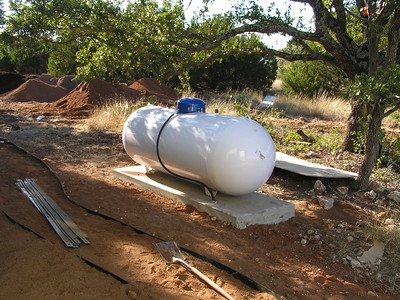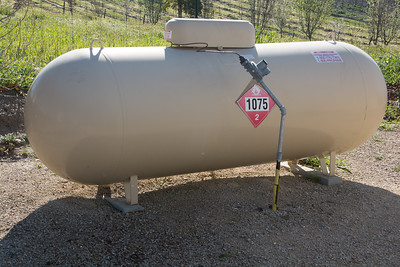
If you have a 500-gallon propane tank on your property, you may already know that it can be an eyesore. You’ve likely invested time and effort into making your outdoor space beautiful and functional, so it’s no surprise that you’d want to find ways to camouflage this bulky necessity.
Fortunately, with a little creativity and planning, you can hide your propane tank effectively, turning it into a well-integrated part of your landscape. In this article, we’ll explore a range of techniques, from natural landscaping to custom enclosures, that will help you conceal your propane tank while ensuring it remains accessible and safe.
So, let’s dive in and discover some inspiring ideas for transforming your property!
Read this article: 500 Gallon Propane Tank Dimension: Is This the Size You Need?
Using Natural Landscaping Techniques
One of the best ways to hide a 500-gallon propane tank is to incorporate it into your existing landscape. By using natural elements, such as trees, shrubs, and mounds, you can create a visually appealing barrier that not only hides the tank but also adds beauty and depth to your outdoor space.
Start by selecting plants that will grow tall enough to cover the propane tank, and consider their growth habits, foliage, and color. Choose a mix of evergreens and deciduous plants to provide year-round coverage, and opt for species that are native to your area to ensure they’ll thrive. Keep in mind that you’ll need to leave enough space around the tank for ventilation and maintenance access, so plan your plantings accordingly.
Creating a berm or mound around the tank is another effective landscaping technique. This raised area can be covered with grass, flowers, or groundcover plants, further enhancing its visual appeal. When designing your berm, make sure it slopes gently to allow for proper drainage and doesn’t obstruct access to the tank.
Incorporating the propane tank into a garden design can also help disguise its presence. For example, you could create a rock garden around the tank, using large boulders and smaller stones to create a natural-looking setting. Alternatively, you could design a perennial flower bed or a small water feature, using the tank as a central element.
Read this guide: Is 500 Gallon Propane Tank The Right Size for Your Home?
Constructing a Decorative Fence or Wall
Building a fence or wall around your propane tank is another effective way to conceal it. This can be a standalone structure or an extension of an existing fence or wall on your property. There are numerous materials and styles to choose from, depending on your aesthetic preferences and budget.
Wooden fences are a popular choice due to their versatility and affordability. You can paint or stain them to match your existing outdoor décor, or let them weather naturally for a more rustic look. Vinyl fences offer a low-maintenance alternative, available in a wide range of colors and styles to suit your taste.
Stone and brick walls can provide a more permanent and substantial barrier around your propane tank. They can be constructed to match the style of your home or other hardscape elements in your yard, creating a cohesive look. Although this option can be more expensive and time-consuming to install, the end result is often worth the investment.
Another option to consider is a lattice or trellis structure, which can be adorned with climbing plants like ivy, clematis, or honeysuckle. As these plants grow and cover the lattice, they’ll create a beautiful, living screen that effectively hides the propane tank while adding visual interest to your landscape.
Installing a Tank Cover or Enclosure
Custom-designed tank covers and pre-fabricated enclosures offer another way to conceal your propane tank. These covers are designed specifically to fit over the tank and can be made from various materials, such as wood, metal, or heavy-duty plastic. They often resemble small sheds or cabinets, allowing them to blend seamlessly with your outdoor space.
Custom-designed covers can be tailored to your specific needs and preferences. You can choose the materials, colors, and style that best match your existing landscape and home design. When opting for a custom cover, make sure to work with a skilled craftsman who understands the ventilation and access requirements of propane tanks.
Pre-fabricated enclosures are a more budget-friendly option, available in a variety of sizes, materials, and styles. When selecting an enclosure, make sure it is large enough to accommodate your 500-gallon propane tank and provides adequate ventilation. You may need to modify the enclosure slightly to ensure proper access for maintenance and refilling.
Alternatively, you can build a shed or small structure around the propane tank. This can serve as a multi-purpose space, providing storage for garden tools or equipment, while also hiding the tank from view. Ensure that your shed design allows for proper ventilation and access to the tank, and consider adding a lock for added security.
Painting the Tank to Blend with Surroundings
Painting your propane tank is a simple and cost-effective way to help it blend in with its surroundings. To achieve the best results, choose a color that complements your landscape, such as earth tones, greens, or even a color that matches the exterior of your home.
Before you start painting, clean the tank thoroughly to remove any dirt or debris. Use a primer specifically designed for metal surfaces, and then apply a high-quality, rust-resistant paint.
Be sure to follow the paint manufacturer’s instructions for application and drying times, and avoid painting any valves, gauges, or other important components of the tank.
Keep in mind that you may need to touch up the paint periodically to maintain its appearance and protect the tank from the elements. Regularly inspect the paint for signs of wear or damage, and address any issues as needed.
Considering Partial Underground Installation
If you’re looking for a more discreet way to hide your propane tank, you might consider a partial underground installation. This involves burying a portion of the tank below ground level, with the top of the tank remaining exposed for ventilation and access.
This method offers several advantages, including reduced visual impact and protection from weather and potential accidents.
However, it’s important to ensure proper ventilation and maintain easy access for maintenance and refilling. Additionally, you’ll need to consult with a professional installer and check local regulations and guidelines to ensure this option is feasible and permitted in your area.
Combining Techniques for Optimal Results
Your property’s unique characteristics and your personal preferences will ultimately determine the best approach for hiding your propane tank. In many cases, combining multiple techniques can yield the most visually appealing and effective results.
For example, you might choose to paint your tank a color that matches your home’s exterior, and then surround it with a wooden fence or lattice covered in climbing plants. Alternatively, you could incorporate the tank into a garden design and construct a decorative wall or berm to further shield it from view.
Regardless of which methods you choose, always prioritize safety and accessibility, ensuring that your tank remains well-ventilated and easy to access for maintenance and refilling.
Conclusion
Hiding a 500-gallon propane tank on your property doesn’t have to be a daunting task. With a bit of creativity and planning, you can transform this essential but unattractive piece of equipment into an integrated and visually appealing part of your landscape.
Whether you opt for natural landscaping, a custom enclosure, or a combination of techniques, the key is to find a solution that suits your unique needs and enhances the beauty of your outdoor space.
Remember that safety should always be a top priority when concealing your propane tank. Keep ventilation and access requirements in mind, and consult with professionals or your local authorities to ensure compliance with any applicable regulations. Regular maintenance and inspection of your propane tank and its surroundings will help keep your property safe and looking its best.
In the end, successfully hiding a 500-gallon propane tank is about striking the right balance between aesthetics, safety, and accessibility. By exploring various techniques and customizing them to your specific situation, you can create an outdoor space that is both functional and visually pleasing.
So, don’t let that bulky propane tank detract from the beauty of your property – get creative, and turn it into a well-hidden asset that contributes to the overall charm of your outdoor oasis.

Jeremy is a highly experienced professional propane technician with over 21 years of experience in the industry. Throughout his career, he has gained extensive knowledge and expertise in propane gas installation, maintenance, and repair, as well as in ensuring safety and compliance with industry standards. Mike has worked with various residential, commercial, and industrial clients, providing top-notch services and solutions to meet their propane needs. He is dedicated to his craft and passionate about delivering exceptional service to his clients.



